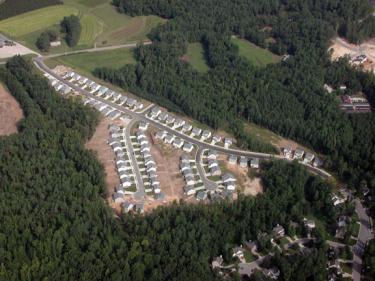Habitat Loss and Degradation
Early European explorers in North America described a land and sky thick with birds, where winged flocks blackened the skies and birdsong echoed through the forests. Human population growth altered that picture rapidly, largely through agricultural development and resource extraction. In some ecosystems, like the tallgrass prairie and South Texas brushlands, all but 5 percent of native habitat has been converted to agriculture or other development. Nearly all of the old growth forests of the Eastern U.S. were cut down more than a century ago to make space for farms and provide wood for fuel and raw materials. Once cleared of native vegetation most ecosystems provide little of the resources needed to sustain wild bird populations. And once disturbed, most ecosystems are slow to recover. Their natural biodiversity and dynamics may be disrupted for centuries or more. Human management practices—like fire suppression and monoculture reforestation—have also impaired the natural processes through which ecosystems heal.
Solutions
- Restore native forest health: Unfortunately, forestry practices of the past did not have the benefit of our modern understanding of forest health. We suppressed fire in places like the longleaf pine forests, which required
periodic fire as a crucial ecosystem disturbance. We planted monocultures of trees in forests where a diverse mix had been the natural norm. And we failed to rebuild all layers of the forest after clear cutting destroyed undergrowth as well as the forest canopy. A natural forest generally contains many layers of vegetative growth from ground cover to the upper canopy. Different birds utilize different parts of the forest—some are generally found in the shrub layer, some in the canopy, while others need dead tree snags. As a woodland owner you can help rebuild forest health by restoring multi-story habitat and leaving old logs and snags. And in some locations working with forestry specialists to restore fire regimens and other native forest dynamics. [maybe link here to the section on how to attract birds to your land, or something else about maintaining multi-story forest health]Restoring native forest health is all about the right place and the right tree.
- Avoid forest fragmentation: You can manage your woods to protect the unbroken tracts of forest interior that are most useful to birds.
- When cutting trees, practice single-tree removal or limit sections of removal to .25 acres while retaining clusters of over-story trees.
- Reduce fragmentation from old, unneeded roads and other forest clearings by planting trees and shrubs in openings.
- Schedule major forest management for late fall and winter: Try to refrain from disruptive land management activities during the bird breeding season—from early spring to early fall.
How can I get more tips?
It’s simple! Enter your email below.


